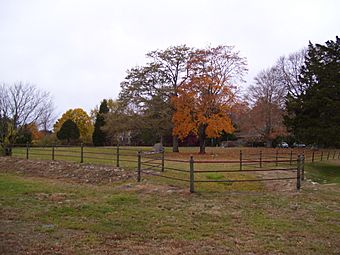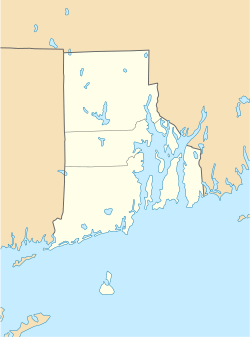Fort Ninigret facts for kids
Quick facts for kids |
|
|
Fort Ninigret
|
|

Fort Ninigret in 2008
|
|
| Location | Charlestown, Rhode Island |
|---|---|
| Built | 1637 |
| Architect | Dutch West India Company |
| NRHP reference No. | 70000004 |
| Added to NRHP | April 28, 1970 |
Fort Ninigret is an old fort and trading spot in Charlestown, Rhode Island. European settlers built and used it in the 1600s. In 1883, a commissioner named George Carmichael, Jr. called it "the oldest military post on the Atlantic coast." This shows it was a very important place for a long time!
Contents
A Look Back: Fort Ninigret's Story
Early Life at Fort Neck
Long before Europeans arrived, people lived on Fort Neck. It wasn't a huge village, but it was home to many. Around 1620, many Niantic families settled here. They were related to the larger Narragansett tribe.
The Niantic people grew corn and made wampum. Wampum are special shell beads. They used these beads like money to trade with Dutch and English colonists. They traded for things like beads, pipes, and copper pots. Ninigret, a leader of the Niantics, is who the fort was named after. He became their sachem (leader) in the 1630s.
Who Built the Fort?
Most historians think the Dutch West India Company built the fort. Some also believe Portuguese explorers might have built it before 1637. There was also an earlier trading post on nearby Dutch Island. One of the first books to mention Dutch forts in Rhode Island was Samuel Arnold's History of the State of Rhode Island in 1858.
In 1921 and 1922, some interesting things were found near the fort. A European sword and a cannon were discovered at an old Native American burial ground. Many other items were found too. These discoveries show that this was indeed a European fort. Today, these old items are kept safe by the Rhode Island Historical Society.
Life After King Philip's War
King Philip's War (1675–1676) was a big conflict. After this war, European colonists gained more control over Native American lands in Rhode Island. However, a special area was set aside for the tribe. This area included much of what is now Charlestown.
Many Narragansett people joined Ninigret's people for safety. Over time, the name Niantic was used less often. At Fort Ninigret, tribal members continued to live in wigwams (traditional homes). This continued into the 1700s. Nearby, the sachems (leaders) lived in European-style houses. They sometimes sold tribal land to colonists to pay off debts. By the 1800s, Fort Neck was the last piece of land the Narragansett tribe owned that had access to the ocean.
A Monument to Friendship
In 1883, the state of Rhode Island changed its relationship with the tribe. Members of the tribe were given the same rights as other U.S. citizens. As part of this change, the state turned the remains of Fort Ninigret into a monument. This monument celebrated 250 years of good relations. It honored the Narragansett and Niantic people and their non-Native neighbors.
The state reshaped the earth banks of the fort. This was done under the guidance of the Narragansett Indian Tribe's commissioners. They planted evergreen trees and put up an iron fence around the fort's old shape. A large rock was moved from nearby hills. Words were carved into it, saying:
Fort Ninigret
Memorial of the Narragansett and Niantic Indians
Unwavering Friends and Allies of Our Fathers
Erected by the State of Rhode Island
Dwight R. Adams, William P. Sheffield, Jr., George Carmichael, Jr.: Comrs
1883
Two members of the Indian Council, Gideon L. Ammons and Joshua H. Noka, spoke at the monument's dedication.
Fort Ninigret Today
In 1983, the U.S. government officially recognized the Narragansett people again. They were once more seen as a tribe. Today, the Rhode Island Department of Environmental Management helps take care of Fort Ninigret. The Charlestown Historical Society also helps maintain it.
Fort Ninigret was added to the National Register of Historic Places in 1970. This means it's a very important historical site. During the 1970s, archaeologists studied the site. They dug there to learn more about its past. These studies were done by the Rhode Island Historical Preservation Commission and by experts from New York University.
Images for kids
-
Tautog Cove in Ninigret Pond, from Fort Ninigret










